This guide is continually updated to ensure accuracy and reflect the latest model information.
Volkswagen may have been late to the SUV boom, but the brand now fields one of the most complete lineups in the segment, spanning affordable compacts, stylish two-row options, and the family-friendly Atlas, plus a growing EV presence with the ID.4 and the returning icon ID. Buzz. The only gap? A true full-size, eight-passenger flagship above the Atlas. Until that arrives, VW’s core SUV range covers most needs. Here, we’ll look at the following:
- Taos (Compact)
- ID.4 (Compact EV)
- Tiguan (Compact)
- Atlas (Mid-size)
- Atlas Cross Sport (Mid-size)
- ID. Buzz (Van/MPV EV)
Volkswagen Taos (Compact Crossover SUV)
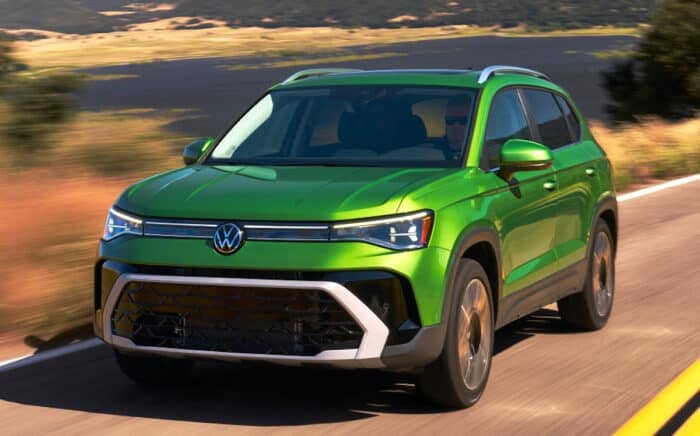
The 2026 Volkswagen Taos stays focused on value, now with a bit more substance behind the styling. Power still comes from the updated 1.5-liter turbocharged four-cylinder introduced for 2025, now making 174 hp and 184 lb-ft of torque, paired with an eight-speed automatic in both front-wheel-drive and 4Motion all-wheel-drive models. It’s not a rocket, but it’s efficient, with EPA estimates up to 31 mpg combined (FWD) and 28 mpg (AWD), and sized right between subcompact and compact rivals. Standard gear is strong for the price: LED projector headlights, 8-inch Digital Cockpit, 8-inch touchscreen with wireless App-Connect, dual-zone climate control, heated steering wheel, and IQ.DRIVE driver assist tech on every trim.
Most of the big changes came with the 2025 refresh, but 2026 quietly builds on that. The lineup now runs S, SE, SE Black, and SEL, with rear-seat belt pretensioners and wireless App-Connect standard across the board, plus quicker 15W wireless charging added mid-year. Upper trims layer in the nicer stuff shoppers in this class increasingly expect—available panoramic sunroof, upgraded CloudTex or leather upholstery, ambient lighting, and now a premium eight-speaker VW audio system on SEL. With generous rear-seat space and a usable cargo area, the Taos remains a practical alternative to a larger Tiguan for buyers cross-shopping the Honda HR-V, Mazda CX-30, Subaru Crosstrek, and Toyota Corolla Cross.
Volkswagen ID.4 (Electric Compact Crossover SUV)
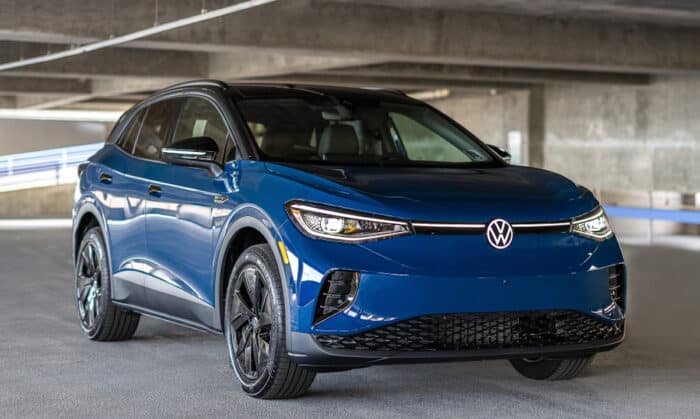
First arriving in 2021, the 2026 Volkswagen ID.4 builds on the big 2024 upgrades and leans harder into everyday EV usability. Still riding on VW’s MEB platform and built in Chattanooga, it pairs a roomy, quiet compact-SUV cabin with a strong, rear-biased electric powertrain: up to 282 hp for rear-wheel-drive models and 335 hp with dual-motor all-wheel drive, fed by an 82-kWh battery. Range remains competitive at up to an EPA-estimated 291 miles for Pro/Pro S and 263 miles for AWD versions, with 175-kW DC fast charging that can take the battery from 10 to 80 percent in about 30 minutes. New for 2026, every ID.4 now includes a NACS DC adapter, opening the door to Tesla’s vast Supercharger network, plus a standard 2-in-1 mobile EV charging cable for home or on-the-go Level 2 charging.
Inside, the ID.4 continues with its high-tech, minimalist vibe: a 5.3-inch ID.Cockpit display ahead of the driver, a 12.9-inch Discover Pro Max touchscreen with revised, more intuitive climate and menu layouts, standard wireless Apple CarPlay/Android Auto, and available Harman Kardon audio on S Plus trims. IQ.DRIVE remains standard across the board, bundling lane centering, adaptive cruise with stop-and-go, blind-spot monitoring, automated parking and Memory Parking into one of the more comprehensive assist suites in the segment. With a simplified trim walk—Entry (Pro, AWD Pro), S (Pro S, AWD Pro S), and S Plus (AWD Pro S Plus)—plus the added charging flexibility for 2026, the ID.4 is a more appealing option for buyers cross-shopping conventional crossovers and newer EV rivals like the Ioniq 5 and Kia EV6.
Volkswagen Tiguan (Compact Crossover SUV)

The third-generation 2026 Volkswagen Tiguan arrives with sharper styling, a more refined cabin, and meaningful performance gains across the lineup. Launched as an all-new model for 2025, the latest Tiguan now feels more premium inside, with higher-quality materials, a streamlined dash design, and large digital displays (a 10.25-inch Digital Cockpit Pro and a 12.9-inch central touchscreen standard). The ride is lighter and more responsive thanks to the updated MQB Evo platform, and a revised 2.0-liter turbocharged four-cylinder now produces 201 hp in most trims—17 hp more than the previous generation—paired with an eight-speed automatic and either front- or all-wheel drive. Driver assistance also steps up: Travel Assist now supports driver-initiated lane changes, joining a long list of standard IQ.DRIVE features that includes lane centering, adaptive cruise with stop-and-go, and emergency braking.
Buyers wanting more punch can now step into the new SEL R-Line Turbo, which swaps in a stronger 268-hp version of VW’s EA888 engine, making the Tiguan one of the more athletic mainstream compact SUVs without sacrificing regular-fuel running costs. Practicality remains a core strength, with generous second-row space, nearly 70 cu-ft of max cargo room, and a two-row configuration tailored to North America. With pricing starting at $30,805 and a wider spread of trims—from understated S to fully loaded SEL R-Line Turbo—the 2026 Tiguan delivers a more upscale, more capable take on one of VW’s key models, targeting shoppers who want something a bit more refined than the class norm.
Volkswagen Atlas (Mid-Size SUV)
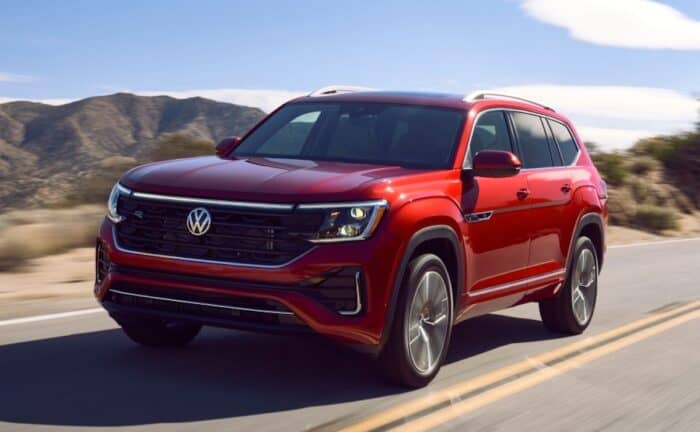
First arriving in 2018, the 2026 Volkswagen Atlas continues as VW’s family-sized three-row mid-size SUV, pairing a genuinely roomy cabin with a simpler, more refined powertrain lineup. Every Atlas now runs the same 2.0-liter turbocharged four-cylinder (EA888 Evo4) with 269 hp and 273 lb-ft of torque, replacing both the old four-cylinder and V6 while delivering stronger torque and similar or better performance on regular fuel. Front-wheel drive is standard, with 4Motion all-wheel drive available across most trims, and rated towing of up to 5,000 lb on properly equipped models keeps it competitive with key rivals. Fuel economy lands in the low-20s combined, reasonable for a big seven-seater. Pricing starts at $39,310 for SE FWD, plus $1,475 destination.
Inside, the Atlas leans hard into comfort and tech—exactly what matters to busy families. A 12-inch floating touchscreen and 10.25-inch Digital Cockpit Pro are standard, along with heated and ventilated front seats with leatherette, a heated steering wheel, and three-zone automatic climate control. Upper trims add available quilted leather with massage, 30-color ambient lighting, and a Harman Kardon audio system, while the Peak Edition brings a tougher look with all-terrain tires and extra cladding. IQ.DRIVE driver-assistance is standard on every trim, with lane keeping, adaptive cruise with stop-and-go, forward collision warning, and blind-spot monitoring all included. With adult-friendly space in all three rows, up to 96.6 cu-ft of cargo room, and a calmer, more upscale cabin than earlier versions, the 2026 Atlas remains VW’s go-to choice for growing families considering a Highlander, Palisade, or Telluride.
Volkswagen Atlas Cross Sport (Mid-Size SUV)
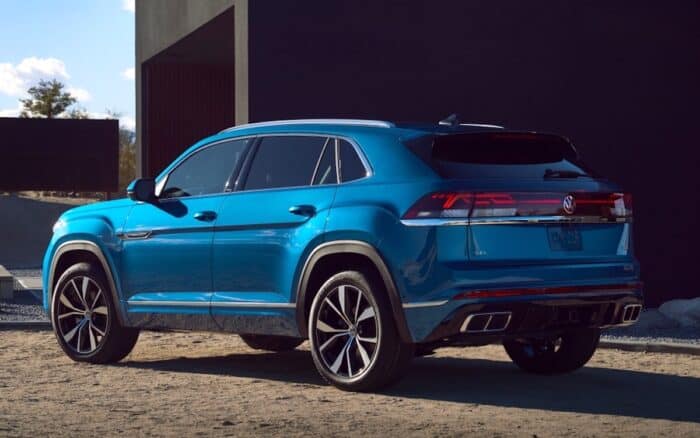
The 2026 Volkswagen Atlas Cross Sport takes everything that works in the three-row Atlas and repackages it into a lower, leaner, more stylish two-row SUV. Same bones, very different vibe. The roofline is lower and more raked, the rear hatch is more coupe-like, and the gloss-black “X” lower fascia and available R-Line Black treatment give it a noticeably sportier stance versus the family-hauler Atlas. It’s still big by midsize standards, with generous rear legroom and up to 77.6 cu-ft of cargo space with the rear seats folded, but this one clearly skews toward empty-nesters, style-conscious families, and outdoorsy couples who don’t need a third row. Pricing starts at $38,300 for SE FWD, plus $1,475 destination.
Under the skin, it mirrors the Atlas: a 2.0-liter EA888 Evo4 turbo four with 269 hp and 273 lb-ft, an eight-speed automatic, and either FWD or 4Motion AWD with multiple drive modes and real 5,000-lb towing capability on most trims. When we drove this in 2020, our feeling was that it’s more of a cruiser than a performer. Inside, you get the same tech-forward cabin as Atlas—12-inch floating touchscreen, 10.25-inch Digital Cockpit Pro, standard heated and ventilated front seats, and three-zone climate control—with the option to move up into quilted leather, front-seat massage, 30-color ambient lighting, and a Harman Kardon audio system. Think of it as the Atlas for people who want space and comfort, but would rather their midsize SUV look like the sporty one in the school pickup lane.
Volkswagen ID.Buzz and ID.Buzz Cargo (Electric Van/MPV)
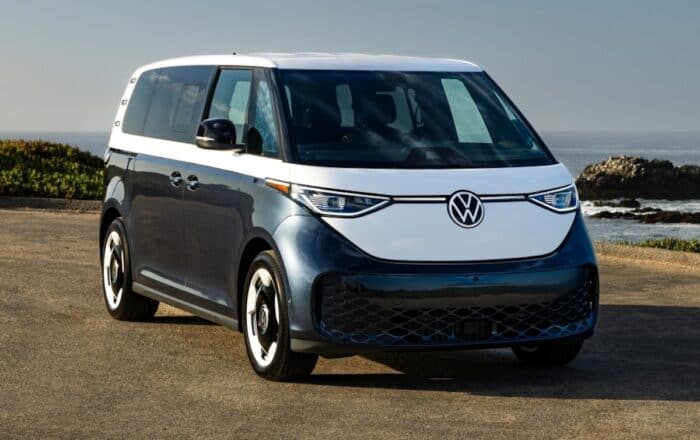
When we first drove this thing, we weren’t sure who would actually buy it. But regardless, the Volkswagen ID. Buzz brings the classic Microbus into the VW EV era, blending retro charm with modern electric performance and family-friendly space. And that’s clearly the appeal. Built on VW’s MEB platform, the long-wheelbase North American version features short overhangs, a huge greenhouse, powered sliding doors, and a design that’s unmistakably inspired by the original Bus—but finished with LED lighting, available two-tone paint, and 20-inch aero disc wheels. Inside, the three-row layout is bright, roomy, and playful, offering up to seven seats, configurable two-tone cabins, and smart storage features like the removable Buzz Box center console. A 12.9-inch touchscreen, 5.3-inch ID.Cockpit display, wireless App-Connect, eight USB-C ports, and available electrochromic panoramic roof bring full modern EV tech to the mix.
All ID. Buzz models use a 91-kWh battery, with 282 hp in rear-wheel-drive versions and 335 hp in 4Motion models. EPA range is up to 234 miles (RWD) and 231 miles (AWD), with DC fast charging up to 200 kW that takes the battery from 10 to 80 percent in about 26 minutes. Standard IQ.DRIVE driver assistance includes lane centering, adaptive cruise with stop-and-go, automatic emergency braking, and Park Assist Plus with Memory Parking. With pricing starting at $59,995 (Pro S), the ID. Buzz isn’t an SUV—but its mix of usability, nostalgia, and EV capability makes it one of Volkswagen’s most distinctive new family vehicles.


